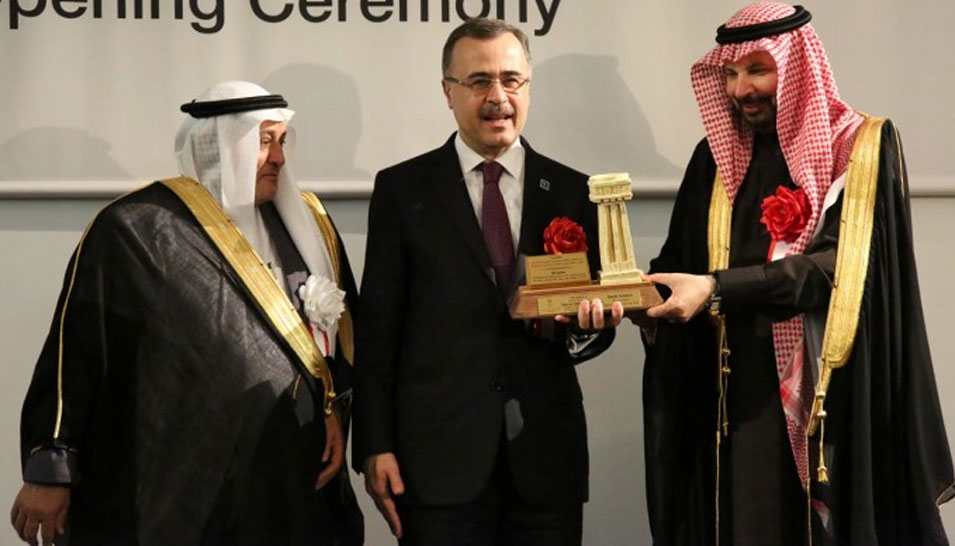
‘Roads of Arabia: Archaeological treasures of Saudi Arabia’ exhibition inaugurated at Tokyo National Museum
- Saudi Aramco's sponsorship of the exhibition is an extension of its commitment to preserve and promote the Kingdom's cultural heritage.
- Co-sponsored by Sumitomo Chemical Co. Ltd. and Showa Shell Sekiyu.
- Asian Tour of the exhibit included China, South Korea, and Japan.
‘Roads of Arabia: Archeological Treasures of Saudi Arabia’ exhibition, a joint initiative of Saudi Aramco’s King Abdulaziz Center for World Culture and the Saudi Commission for Tourism and National Heritage (SCTH), co-sponsored by Sumitomo Chemical and Showa Shell was inaugurated today at the Tokyo National Museum in the Japanese Capital, Tokyo, the third leg in the exhibition’s Asia tour, which included Beijing and Seoul.
The inauguration ceremony was attended by the ambassador of the Custodian of the Two Holy Mosques to Japan, H.E. Ahmad Al-Barrak; Amin H. Nasser, Saudi Aramco President and Chief Executive Officer; Said Hadrami, Saudi Aramco Vice President for International Operations; Anwar Hejazi, Aramco Asia President; Zeniya Masami, Tokyo National Museum Executive Director; Tsuyoshi Kameoka, Showa Shell Sekiyu President, Representative Director & Group CEO; Osamu Ishitobi, the Chairman of the Board and Chief Executive Officer at Sumitomo Chemical Company; and a high level delegation from Japan's Ministry of Foreign Affairs and the Ministry of Education, Culture, Sports, Science and Technology and, several diplomatic, business and cultural dignitaries.
Before arriving in Japan, Roads of Arabia spent most of 2017 touring the major museums in China and South Korea, during which the exhibition was visited by more than 290,000 visitors. The relics exhibited at Roads of Arabia are expected to captivate the hearts and minds of Tokyo’s knowledge-craving visitors. Established in 1872, the Tokyo National Museum is the oldest Japanese national museum, and the largest art museum in Japan and the world. The exhibition will remain on display for three months before it sets sail again to new destinations.
Speaking at the inauguration ceremony, Amin H. Nasser, highlighted that across the globe and throughout the ages, roads have proven to be the fabric of society. He said “Long before either of our two countries became modern nation-states, the exchange of trade and tradition between our ancestors helped shape the world for centuries. With Roads of Arabia, we bring you a sort of cultural map that explores this rich history.”
Nasser continued: “From the earliest days of civilization, the Arabian Peninsula has been a venue for commercial trade, and a nexus for merchants and artisans, a place marked by cross-cultural engagement and an exchange of art, culture and ideas extending even as far as Japan.”
Highlighting this diverse and dynamic relationship, Nasser added: “With the State visit of the Custodian of the Two Holy Mosques to Tokyo in March 2017, we were reminded that while the official Japan-Saudi relationship is comparatively young, it is strong. Through the efforts of King Salman and Prime Minister Shinzo Abe, Saudi-Japan’s Vision 2030 will see a strong partnership grow even stronger in the decades ahead.”
Reflecting on the future relations between Saudi and Japan, Nasser added: “As the Kingdom works to diversify its economy into new sectors, Japan is poised to boost exports, investments and tourism beyond Asia. And through Roads of Arabia, we are also helping pave new roads of culture and people-to-people contacts, all of which are essential for true prosperity.” Nasser added: “once again, though we occupy distant ends of the Asian continent, it seems as if history invites our peoples to build a stronger future together.” As part of Vision 2030, Saudi Aramco is strengthening its focus on building bridges of trade, commerce and partnership with Japan – and this extends well beyond the energy sector. In recent decades, for instance, thousands of Saudi Arabia’s best and brightest students have studied in Japan. In fact, many are sponsored by Saudi Aramco, and go on to spend their careers with the company. This term, twenty-eight (28) Aramco-sponsored students are pursuing their education learning about Japanese society, culture, values and traditions, while building bonds of friendship that will last a lifetime.
Nasser concluded his remarks by thanking the organizers, co-sponsors, the representatives from the Japanese government and extended his appreciation to His Royal Highness Prince Sultan Bin Salman, the President of the Saudi Commission for Tourism and National Heritage for bringing these incredible artifacts to the attention of the Japanese public and the wider world.
Featuring important archaeological relics illustrating the depth of the Arab civilization and its history of more than one million years, the exhibition features more than 466 archaeological pieces assembled from the National Museum in Riyadh, the King Saud University Museum, and other local museums of Saudi Arabia.
The artifacts on display, cover the prehistoric and pre-Islamic periods, the early, middle, and late Arabian kingdoms and civilizations, and the Islamic period until the establishment of the Kingdom throughout its three stages until the reign of King Abdulaziz, some of which are publicly displayed for the first time.